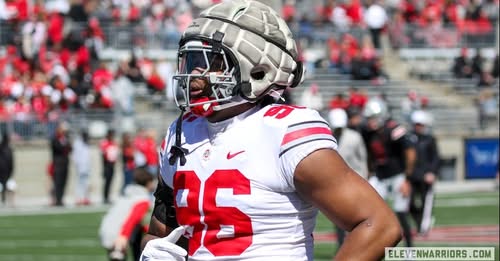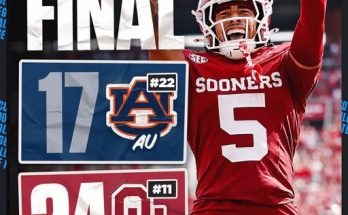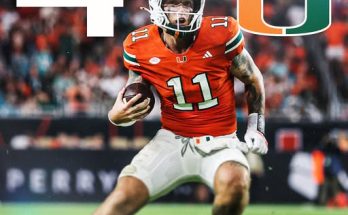The early days of college football fall camp are always a delicate balance of excitement and apprehension. For fans, it’s the thrilling beginning of a new season, a time filled with the hope of championships and the promise of new heroes. For coaches and players, it’s a period of intense work and high-stakes evaluation, but it also carries the inherent risk of injury, a cruel twist of fate that can derail months of preparation in a single, devastating instant. This palpable tension was on full display in Columbus as the Ohio State Buckeyes took the field for their first official practice of the season. All eyes were on the highly touted team, a squad with national championship aspirations and a revamped roster that was already generating immense buzz. The energy was electric, but it was quickly tempered by a moment of collective fear when sophomore defensive tackle Eddrick Houston went down with a lower-leg injury, a sight that sent a jolt of concern through the entire program. In a game of inches and split-second decisions, the fate of a season can sometimes hang on the health of a single player, and for a moment, it seemed as though the Buckeyes’ lofty goals were in jeopardy. However, a sense of profound relief washed over Buckeye Nation just a few hours later, thanks to a report from ESPN’s Pete Thamel, who delivered the news that Houston’s injury was not expected to be serious and did not appear to be long-term. This update, while seemingly minor in its brevity, was monumental in its implications, allowing the team and its supporters to breathe a collective sigh and refocus on the immense potential that lies ahead.
For a program as storied and successful as Ohio State, the pressure to perform is a constant. The Buckeyes are not just expected to win; they are expected to dominate, and their path to a national title is often paved by a suffocating defense. Central to that defensive identity is the play of the interior defensive line, a position group that has been a source of both strength and, more recently, some concern for the team. With the departure of a number of key players to the NFL, the defensive tackle position was a significant question mark heading into the season. The spotlight was already shining brightly on Eddrick Houston, a former five-star recruit who had shown flashes of his immense talent as a true freshman. He was not just expected to fill a void; he was being counted on to be a game-wrecker, a disruptive force who could collapse the pocket and stop the run. His progress during spring ball had been a major talking point, and his development was considered crucial to the success of the entire defensive unit. The moment he went down, helped off the field by trainers, the gravity of the situation was instantly understood by everyone watching. A serious injury to a player of his caliber at a position of such critical need would have been a catastrophic blow to the team’s championship hopes.
The immediate aftermath of an injury is a period of speculation, rumor, and anxiety. Social media explodes with every angle of a video, every unconfirmed report, and every fan’s worst fear. In this environment, the role of a trusted, well-sourced journalist like Pete Thamel becomes invaluable. His report, delivered with the speed and authority of a reputable insider, cut through the noise and provided a much-needed sense of clarity. The news that the injury was not long-term allowed everyone to exhale. It meant that the Buckeyes would not be without their projected starting defensive tackle for the duration of the season, a fate that would have forced them to rely on an even more inexperienced group of backups. While the exact nature of the injury—a low-grade sprain, a minor muscle issue—was not specified in the initial report, the timeline offered a crucial piece of the puzzle: Houston would likely miss some practice time and perhaps some early-season action, but he would be back. This news was the best-case scenario for a team that has to navigate a grueling schedule, including a massive early-season showdown against a formidable opponent.
The temporary absence of Eddrick Houston, while not ideal, presents a unique challenge and opportunity for the Ohio State coaching staff and the rest of the defensive line room. It will force players who are currently behind Houston on the depth chart to step up and prove their worth. This could be a chance for a player like Will Smith Jr., the son of a former Buckeye great, or a transfer like Tywone Malone to get valuable first-team reps. In a sport where depth is a key determinant of success, forcing the hand of a coaching staff to develop their backups can sometimes be a blessing in disguise. The experience gained by these players in Houston’s absence could pay dividends later in the season, when injuries inevitably pile up and fresh legs become a precious commodity. It also puts the onus on the coaching staff to find creative ways to maintain their defensive integrity without one of their key players, a test of their strategic acumen that could make them a more formidable unit in the long run.
Beyond the immediate tactical implications, the report on Houston’s injury has a more profound effect on the morale and psychology of the team. The first day of fall camp is often an emotional rollercoaster, and a serious injury can cast a long, dark shadow over a locker room. The news that Houston’s injury is not long-term allows the team to refocus. It’s a moment of adversity that was quickly navigated, a brief scare that will serve as a reminder of the fragility of the season without becoming its defining tragedy. The coaches can continue to push their players, and the players can continue to practice with the knowledge that their teammate will be back on the field with them soon. It keeps the team’s goals and aspirations intact and prevents the kind of emotional drain that a season-ending injury can inflict on an entire program.
Ultimately, the story of Eddrick Houston’s injury scare is a microcosm of the entire college football season. It is a narrative filled with high hopes, unexpected setbacks, and the resilience required to overcome them. The initial fear that his injury might be season-ending was a stark reminder of how quickly the best-laid plans can go awry. However, the subsequent report from a respected journalist offered a crucial reprieve, allowing the story to pivot from one of potential tragedy to one of temporary adversity. For Ohio State, the road to a national championship is still long and full of obstacles, but thanks to this positive news, they will be able to face those challenges with their full complement of talent, even if it takes a few weeks for one of their most important players to get back to full health. The Buckeye faithful can now return to their state of cautious optimism, knowing that their defensive line, a unit so central to their hopes, will not be crippled by a single, unfortunate moment at the start of fall camp.



